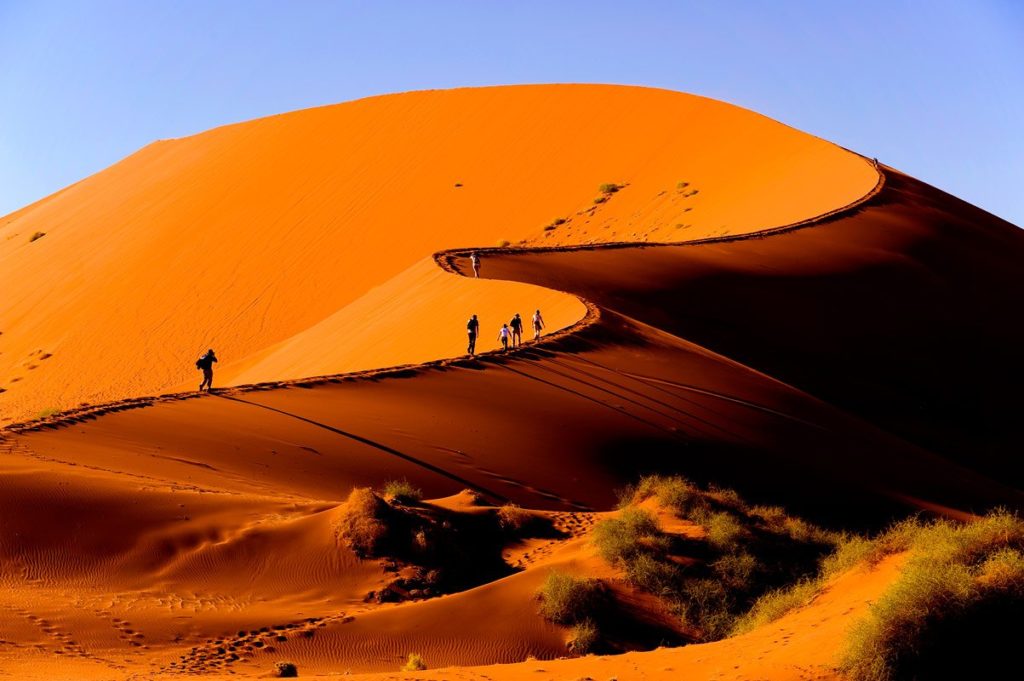Situated in one of the largest conservation areas in Africa (the Namib-Naukluft National Park), Sossusvlei is possibly Namibia’s most spectacular and best-known attraction.
Characterised by the large red dunes that surround it, Sossusvlei is a large, white, salt and clay pan and is a great destination all year round.
The dunes in this area are some of the highest in the world, reaching almost 400 meters, and provide photographic enthusiasts with wonderful images in the beautiful morning and evening light.
The main attractions in the vicinity of Sossusvlei include Sesriem Canyon, Dune 45, Hiddenvlei, Big Daddy and Deadvlei. All of these attractions can be accessed from the road that takes you to Sossusvlei and all are well worth a visit. Only the last 5 km of the 65 km drive to the vlei are not tarred. Shuttles provide access to the last 5 km, should you not have a 4×4 vehicle.
Sossusvlei Attractions
Sesriem Canyon is located approximately 4.5 km from the entrance gate of the Namib-Naukluft National Park. The Tsauchab River has shaped the canyon over millions of years and it is one of the few places in the area that holds water all year round.
There are parking facilities so that visitors can park their vehicles and take a walk through the canyon. The canyon is narrow in places, but it is worth exploring due to the stunning rock formations.
Dune 45 is so named as it is situated 45 km from the Sesriem gate, along a paved road. Its fascinating shape and accessibility make it the most photographed dune in the world.
Visitors are allowed to climb Dune 45, so be sure to visit early in the morning to watch the sunrise over the vlei from the top of the dune. The Dune is roughly 85 meters high and the climb is well worth the effort as from the top you will be spoilt with the incredible panoramic view of Dune Valley. In the morning and evening light, the floor of the pan has been described as a “moonscape” and is truly a sight to behold.
Big Daddy is the tallest dune in the Sossusvlei area. This magnificent dune is situated between Sossusvlei and Deadvlei and at around 325 meters it dwarfs the other dunes. Should you want the ultimate bragging rights, take a lot of water and trek to the top of Big Daddy where you can look down onto Deadvlei.
Close to Sossusvlei, Deadvlei is a clay pan punctuated by dark, dead camelthorn trees contrasted against the white pan floor. The pan was formed when the Tsauchab River flooded and the abundance of water allowed camelthorn trees to grow.
However, the climate changed and the sand dunes encroached on the pan, blocking the river from reaching the area. The trees are estimated to be approximately 900 years old, but they have not decomposed due to the dry climate.
Deadvlei is a paradise for photographers as the contrast between the pitch-black trees and bleached-white pans, and the rusty-red dunes and deep blue sky, make for incredible images. Deadvlei is at least 1 km walk from the parking lot so be sure to take drinking water with you.
Activities
The Namib Desert has a number of activities for visitors to enjoy. Take your pick from a host of activities and experience the desert’s beauty from all angles, from quad biking in the dunes, to nature walks, to hot-air balloon flights, scenic microlight flights and so much more.
Wildlife
Some of the larger birds and mammals you will see around Sossusvlei are ostrich, springbok and gemsbok, all of which are remarkably well-adapted to the seemingly inhospitable environment. Larger predators include spotted hyena and brown hyena. In the evenings, when the air is cooler, you may be lucky enough to spot some smaller mammals such as the bat-eared fox, black-backed jackal, porcupine, Cape fox and aardwolf. There are also a variety of snakes and lizards around.

